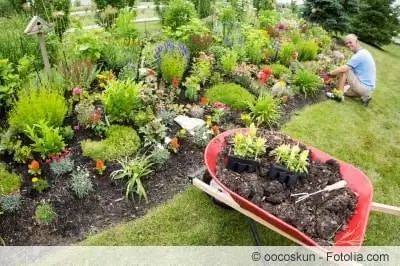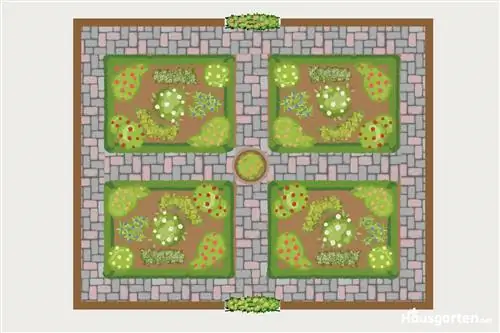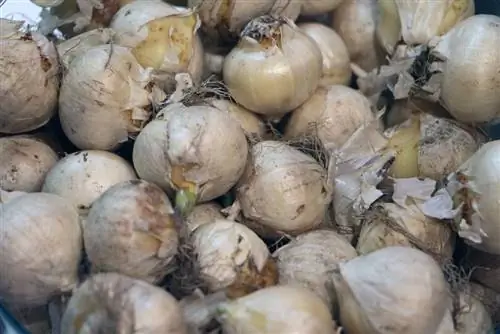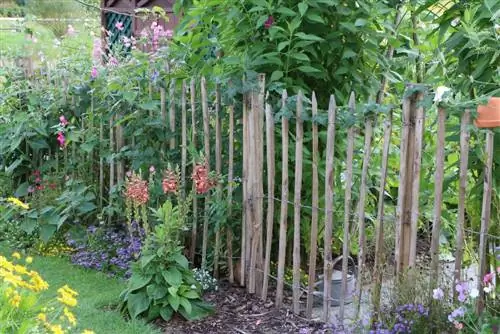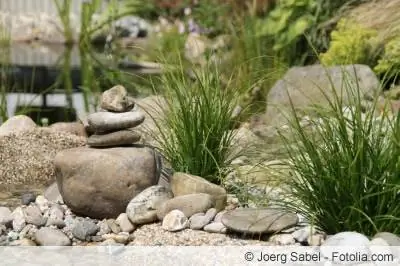- Author admin [email protected].
- Public 2023-12-17 03:39.
- Last modified 2025-01-24 12:45.
A flower bed only looks lush when several plants are in full bloom at the same time. It is best to place plants of the same species in different places in the bed. This repetition can avoid a disorganized mess in the bed. It's best to limit yourself to two to three colors or simply use different tones of one color. In addition, many flowers appear better when planted in smaller groups.
Shape and position
First of all, a gardener has to think about which part of the garden he wants to create a flower bed. Once you've found the space, the shape sometimes comes naturally. There are almost no limits to the size and shape.
- round
- square
- rectangular/diamond-shaped
- curved shapes
- other geometric shapes
- narrow border beds and path borders
Tip:
The best thing to do is to make a plan of the garden with paths on paper (graph paper) and first draw your designs “wildly”. You're sure to come up with some really good ideas.
Check lighting conditions
Once the right place has been found, it should be checked whether the location is fundamentally suitable for the desired planting. Especially when specific plants are desired.
- full sun(including midday sun): ideal for a rock garden or steppe planting
- sunny to partially shaded (a few hours of shade daily): favorable conditions for almost all plants and flowers
- shady: There are also a number of suitable plants here
Floor
Of course, what can be planted also depends on the condition of the soil. In many well-maintained areas, the gardener has already ensured in advance that the soil has ideal conditions for as many plant varieties as possible. These include:
- good water permeability (improvement with sand)
- balanced nutrient levels (incorporate fertilizer or compost)
- medium humus content (compost or good potting soil)
- slight acidity (pH values between 6.0 and 6.8)
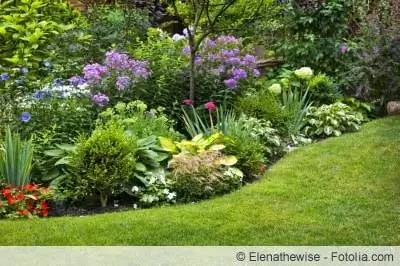
You also have to decide whether a bed border should be created and a weed fleece should be placed in the ground.
Tip:
Before planting the flowers, the soil should be dug about 30 centimeters deep and possibly amended with sand or humus. In addition, all old plant parts such as roots or weeds must be removed. Now is also the time to fertilize. An ideal foundation is created with ripe compost.
Decision for the plants
First and foremost, the plants for the flower bed must be selected based on the site conditions. The nature of the soil and the amount of direct sunlight that falls on the bed are of crucial importance here. To ensure that the combination of plants in the bed turns out well, there are a few simple rules that every gardener who wants to create a flower bed should follow.
1. Lead plants/lead perennials
First you should decide which plant should take a dominant position. The so-called leading plants are higher-growing perennials or small bushes that are particularly expressive and therefore determine the appearance of the bed. The rest of the planting must be based on these key plants, of which only a few may be used. Too many (and too many different) leading plants only reduce the visual impact. Lead plants should always be placed in the back third of the bed (in the middle for round beds). Possible leading plants can be:
- Flame Flowers
- Roses (upright growing types)
- Lilies
- larkspur
- Steppe candles
- Black Cohosh
2. Companion plants
Various companion plants are now selected to match the one or two leading plant species. They are a little smaller than the main perennials and are generally less noticeable. In principle, all flowering, medium-tall perennials and also medium-tall grasses are suitable here. The bed is particularly effective when the accompanying plants
- bloom in a similar color to the leading perennial
- represent a complementary color (orange to blue, purple to yellow, green to red)
For medium-sized flower beds, around three to five different companion perennials are recommended. The best effect is achieved if the perennials are not arranged individually, but as a smaller group of at least three plants (or more) around the main perennials. Examples of companion perennials:
- Columbine
- Asters
- Lupins
- Girl's Eye
- Roses
- Coneflower
- Daylilies
3. Filler plants
If the companion plants are loosely positioned around the leading perennials, the remaining gaps are filled with filler plants. Ground cover plants are ideal for the front bed area, while medium-high foliage perennials are the perfect choice for the middle and back areas of the flower bed.
Ground cover:
- Cushion Carnations
- Cushion phlox
Foliate perennials:
- Funkie (Hosta)
- Ferns
- Grasses
Flowers all year round

The most difficult job is to select plants that have different flowering times for each type of perennial. Because this guarantees that there will always be an eye-catcher in the flowerbed from spring to autumn.
- early flowering plants
- late flowering plants
- Perennials that bloom almost all year round
- possibly evergreen plants or grasses for winter effect
Themed beds
Flower beds that follow a certain basic principle have a special appeal. Such a theme also simplifies the selection of individual perennials from the almost infinite variety of suitable plants.
- Tone on tone
- Mixture of pink, white and blue
- White flowers against a dark green background
- Light blue and yellow
- Violet and dark yellow
- Blue and Orange
- Japanese beds, steppe beds, rockery beds, heather garden beds
Planting spacing
Flower beds don't grow overnight. Even if the planting looks a bit sparse at the beginning, the flowers must not be planted too densely. They usually take about three years to reach their size. If planted too closely, they hinder each other's growth because they compete for light and nutrients. The following applies as a guideline:
- half the height (mature plant) should be maintained as the planting distance
- for leading perennials (large plants): 60-80 cm
- for companion perennials (medium-sized): 40-50 cm
- Ground cover and other weak-growing plants: 15-20 cm
Planting Examples
No matter whether the soil is moist or dry and the location is sunny or shady, there are a number of suitable plants for every location that thrive under these conditions.
Very sunny, dry locations with nutrient-poor soils
Ideal conditions for prairie or steppe gardens. Plants are used here that require little water and nutrients and can easily tolerate direct sunlight. These beds are very easy to care for, only pruning is necessary after winter.
- Leading perennial: Banat globe thistle (Echinops bannaticus, 150 cm)
- Companion perennial: Purple coneflower (Echinacea purpurea, 80 cm), blue rue (Perovskia abrotanoides, 50-80 cm)
- Filler plant: Feather grass (Stipa tenuissima, 40-50 cm)
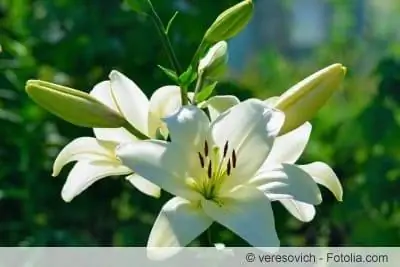
Sunny to partially shaded beds, humus-rich soil
Most plants grow optimally under these conditions. The selection of perennials is almost unlimited.
Blue and white combination (bed size about 2 x 2 meters)
- Leading perennials: 2 blue-violet flame flowers (Phlox paniculata), 1 white delphinium (Delphinium cultorum 'Pure white')
- Companion perennials (rear area): 1 white coneflower (Echinacea), 1 Frikart's aster (Aster x frikartii 'Monk'), 1 magnificent candle (Gaura lindheimeri), 2 white autumn anemones (Anemone japonica), 2 feather bristle grasses (Sedum spectabile) Accompanying perennials (front area): 2 white stonecrops (Sedum spectabile), 2 white gypsophila plants (Gypsophila paniculata) and 2 lavenders (Lavandula angustifolia)
- Filling plants (front area): 3 x cranesbill (Geranium magnificum) on the right and left, 3 white sage (Salvia nemorosa) in the middle
edge beds
Roses are a really timeless and always beautiful planting idea for narrow, sunny border beds. They can be combined well with the following plants because, like roses, these plants bloom for a very long time and require similar location conditions:
- larkspur
- Lavender
- Sage
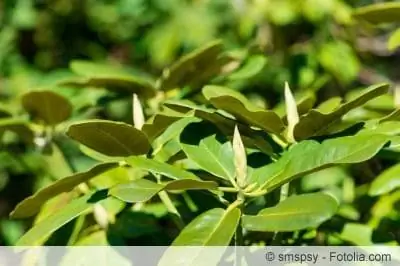
Partially shaded to shady beds with moist soil (approx. 2 x 3 meters)
Plants that stand out with their bright colors look particularly good in a shade garden.
- Leading perennial: 1 blue monkshood (Aconitum) and 1 display leaf (Astilboides tabularis) and 1 royal fern (Osmunda regalis)
- in the row before: 1 penstemon (Penstemon digitalis), 1 glossy shield fern (Polystichum aculeatum) and 1 beardgrass (Schizachyrium scoparium)
- in the row before: 2 real Solomon's seals (Polygonatum multiflorum), 2 Jacob's ladder 'Purple Rain' (Polemonium yezoense)
- at the very front: 4 x snake's beard (Ophiopogon planiscapus nigrescens), 3 light green hostas (Hosta), 2 woodruff (Galium odoratum)
Conclusion
Designing a flower bed is not that difficult. Once you have found a suitable spot, it is best to first look for one or two large leading perennials that match each other in color. Next, groups of half-height companion perennials are planted around these lead perennials. They should have different flowering times and match the color of the main perennials. In the gaps (and the front area) some ornamental foliage plants or ground cover plants will ultimately be added. Important: Pay attention to site conditions and planting distance!

